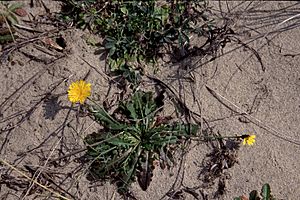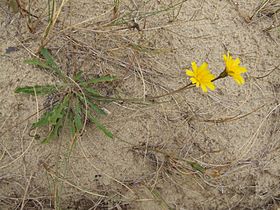Lesser hawkbit facts for kids
Quick facts for kids Lesser hawkbit |
|
|---|---|
 |
|
| Scientific classification | |
| Genus: |
Leontodon
|
| Species: |
saxatilis
|
| Synonyms | |
|
List
|
|
Leontodon saxatilis, also known as the lesser hawkbit, rough hawkbit, or hairy hawkbit, is a type of plant. It looks a lot like a dandelion! This plant originally comes from Europe and North Africa. However, you can now find it in many other places around the world. Sometimes, it grows where people don't want it, becoming a weed.
Contents
About Lesser Hawkbit
This plant is a type of herb that grows in patches. It has many straight stems that don't have leaves on them. These stems grow from a group of leaves at the base of the plant, called a basal rosette.
What Does It Look Like?
The leaves of the lesser hawkbit are usually green. They can be anywhere from 2 to 15 centimeters (about 1 to 6 inches) long. They are also about 0.5 to 2.5 centimeters (about 0.2 to 1 inch) wide. The edges of the leaves can be smooth or have small lobes, which are like rounded sections.
Its Flowers
At the top of each stem, you'll find a single flower head. These flower heads look like a single flower, but they are actually made up of many tiny flowers called florets. These florets are all yellow and have tips that look like they've been cut with tiny teeth. The flower heads are made of layered rings of these yellow florets.
Seeds and How They Spread
After the flower blooms, it produces fruits. These fruits are like tiny, cylindrical seeds. Each seed has a special structure called a pappus. This pappus is made of small scales. It helps the seeds float in the wind, just like dandelion seeds do. The seeds that grow in the center of the flower head are rough. But the seeds that grow along the edges of the flower head are smooth. This difference helps them spread in different ways.
Where Does It Grow?
While Leontodon saxatilis is native to Europe and North Africa, it has spread to many other parts of the world. It can often be found growing in disturbed areas. This includes places like roadsides, fields, and lawns. Because it spreads easily, it is sometimes considered an introduced species or even a noxious weed in new areas.


